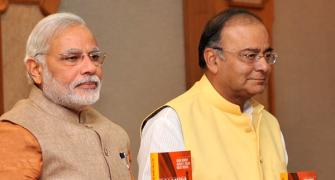 Those in the lower age brackets could do away with traditional plans and hold Ulips. Or, convert all investment plans into a paid-up one.
Those in the lower age brackets could do away with traditional plans and hold Ulips. Or, convert all investment plans into a paid-up one.
Come tax-saving season and Nagpur resident Bhawartha Darwatkar, 32, was most likely to buy an insurance-cum-investment plan.
Between 2007 and 2013, he accumulated two unit-linked insurance policies (Ulips) and a money-back plan.
He reasons: “These policies were purchased without any goal in mind. I was single then and had some good surplus to park. Also, I wanted to get tax benefit.”
He pays Rs 55,000 a year towards a money-back policy and Rs 30,000 towards a unit-linked child plan.
He has another limited pay Ulip, for which he paid Rs 50,000 from 2010 to 2012.
The good part: He has an online term cover of Rs 1 crore (Rs 10 million) and health cover of Rs 500,000.
He has also invested in National Saving Certificate and Post Office deposit.
Darwatkar, who works for a three-star hotel, earns close to Rs 800,000 a year.
Media professional Anjan Chowdhury’s is a worse case.
He takes home Rs 750,000 annually. And, puts Rs 350,000 across five insurance plans -- Rs 25,000 each in two Rs 500,000 endowment plans, Rs 50,000 each in two Rs 900,000 endowment plans, Rs 100,000 in a Rs 20-lakh (Rs 2-million) money-back plan and another Rs 100,000 in a Ulip.
“I picked up the Rs 100,000 premium plans in the last two years, so that I don't need to look for any more instruments to invest in,” says the 35-year old.
Both Darwatkar and Chowdhury want to start taking equity exposure and get rid of ulips.
Where to start?
According to certified financial planner Suresh Sadagopan that’s not the right way to plan a clean-up act.
“The belief that traditional plans (endowment or money-back) are better than Ulips is a myth.
“One, insurance plans are not investment vehicles.
“But if you hold these, choose Ulips over traditional ones because the former are comparatively transparent.
“And, for 30-year olds, Ulips give the equity edge.
“That is, over five years or more, there are higher chances of making 10-12 per cent with Ulips than with a traditional plan,” he explains.
Endowment plans offer a post-tax return of 5-6 per cent and money-back offers around 4 per cent (because it pays out in parts over the policy term).
Hence, between these two, prefer an endowment one.
Instead Sadagopan advises Public Provident Fund and Equity-linked Savings Scheme, taking into account the information available.
Adds S Sridharan, head, financial planning, at FundsIndia.com, even from a tax saving point of view, one should have 30 per cent of the Section 80C limit of Rs 150,000 into provident fund (EPF + PPF), up to 15 per cent in pure life insurance, 50 per cent in ELSS and the rest in unit-linked child plan or 60 per cent in ELSS (as these individuals can take equity-related risks).
“Given these policies were bought to save taxes, they should also check if their policies are beyond the restrictive period prescribed under Section 80C.
If not, then their previous tax benefits will also get reversed,” says Vivek Rege of VR Wealth Advisors.
By Section 80C(5), if one surrenders a non-ulip (single or regular premium) within two years of buying it, all the tax benefit gained from the policy in the preceding years also gets reversed.
Similarly, for ulips, the restrictive period is five years. For instance, Darwatkar bought the unit-linked child plan in 2010.
The policy will complete the restrictive period in 2015. Hence, Rege advises he stick to this plan.
What to do
Taking all these factors into account, the common view is that Darwatkar and Chowdhury convert their insurance plans into a ‘paid-up policy’.
They will need to inform their insurance companies about this decision.
“Using the paid-up option helps keep policy active and frees up cash.
“However, the benefits under the policy reduce in proportion to the premiums paid,” explains certified financial planner Malhar Majumder.
Paid-up value is usually calculated as the number of premiums paid multiplied by sum assured, divided by the total number of premiums.
For instance, if a policy with sum assured of Rs 500,000 and policy term of 15 years had to be made paid-up after five years of paying Rs 25,000 premium, the sum assured would be reduced to Rs 166,000.
This value will be paid on death of the insured or on maturity of the policy.
However, conversion to paid-up works better for traditional plans, where surrender charges are high -- 30 per cent in the second and third years and 70 per cent in the fourth year, excluding the first year premium.
Also, by surrendering, you lose the life cover.
In the case of Ulips, it might be better to surrender, say experts.
For Ulips charges eat into the fund value -- policy allocation fee (seven to 10 per cent in the initial years), a policy administration fee (a percentage of the premium), mortality and fund management charges (1.35 per cent a year).
Comparatively, Ulips’ surrender charge are less at 10-15 per cent in the initial years and lower after the fifth year.
Additionally, Ulips anyway have a lock-in period of five years and one will have to continue paying for this period.
Traditional policies’ charge also eat into the fund value but have an opaque charge structure.
As the maturity benefits are known, you can calculate the attractiveness of continuing with the policy.
Majumder suggests comparing the Ulip performance to mutual fund performance, if the Ulip is old.
“If one has paid for Ulips for five years, this means all the front-end charges have been largely paid.
“As the markets have recently returned decently well, in all probability an all-equity Ulip fund might have performed at par with an equity mutual fund. If so, continue with the Ulip premium,” he says.
But if one holds one of those ulips that are very expensive even in later years (beyond five years), then do away with those.
Experts advise Darwatkar and Chowdhury against buying any more insurance plans. Chowdhury should surrender some traditional plans and buy a term, health cover.
Anjan Chowdhury
Age: 35; Income: Rs 7.5 lakh/year
INVESTMENT ADVICE
- Get rid of older traditional plans; at best hold one
- Get rid of the Ulip as it is expensive
- Buy term and health insurance on priority
- Given EPF contribution from salary is low; start a PPF account
- Pay attention to diversifying your portfolio across instruments
- Divert the cash freed up to equity MFs by way of SIP; at least invest in ELSS
- At this age have at least a 70:30 equity:debt allocation
Bhawartha Darwatkar
Age: 32; Income: Rs 8 lakh/year
INVESTMENT ADVICE
- Convert traditional plans to paid up
- May want to retain the child plan; but investing for child's future through MF could get higher returns
- May want to get rid of the other ulip given car loan may end this year
- Have sufficient term and health cover so far
- Divert the cash freed up to equity MFs by way of SIP; at least invest in ELSS
- At this age have at least a 70:30 equity:debt allocation
- Look at having liquid cash in hand for emergency purpose










